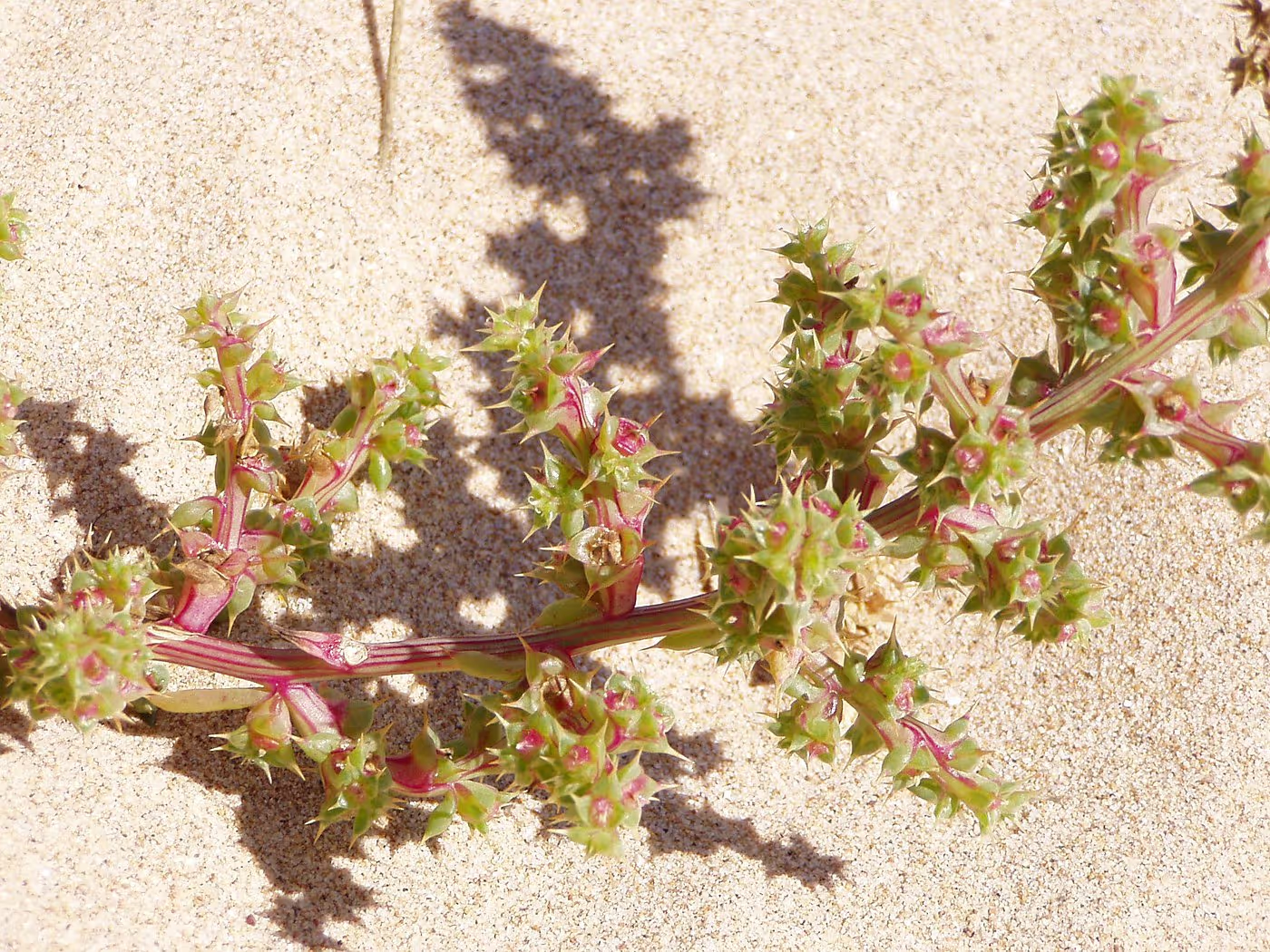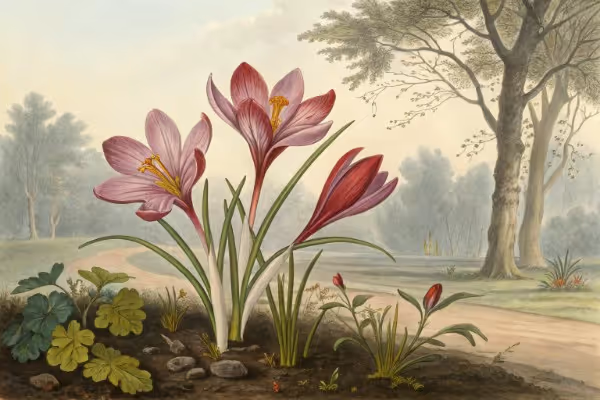Growing Saltwort: How to Plant and Care for Healthy Saltwort

Growing Saltwort
Curious about growing saltwort? This hardy, seaside-loving herb thrives in sandy, salty soil, ideal for coastal gardens or pots with good drainage. Sow seeds in early spring, water sparingly, and watch your saltwort flourish into a crunchy, salty treat—perfect fresh or sautéed. Follow along and let's get growing.
Cheatsheet: Saltwort Planting & Care Guide
🌱 Site & Soil
- Full sun maximizes growth.
- Thrives in sandy, well-drained soil; tolerates salty soils.
- pH: 6.5–8
🕒 Sowing & Spacing
- Direct sow after last frost; soil ≥60°F (16°C).
- Scatter seeds thinly; cover ⅛ in (0.3 cm) soil.
- Rows: 12–18 in (30–45 cm) apart.
- Thin to 4–6 in (10–15 cm) apart.
💧 Watering & Feeding
- Water regularly; let soil dry between waterings.
- Tolerates brackish or slightly saline water.
- No fertilizer needed; overfeeding reduces flavor.
🌿 Growth & Harvest
- Harvest 30–70 days after sowing.
- Use scissors to snip 4 in (10 cm) tips. Regrows for multiple harvests.
- Fresh or blanched: rich in minerals, vitamins A & C, antioxidants.
- 100g provides 20% daily sodium, supports hydration.
🛠️ Tools and Products You'll Need
- Hand trowel
- Watering can
- Scissors or snips
- Saltwort seeds
- Sandy seed-starting soil
- Saline or tap water
🦠 Pest & Disease Management
- Rarely affected by pests.
- Rotate crops to prevent root rot.
- Use mulch to control weeds.
Loosen soil, remove weeds; ensure sand or fine gravel present.
Scatter seeds, cover lightly, water gently.
After sprouting, thin to 4–6 in (10–15 cm) spacing.
Irrigate weekly; avoid soggy soil; weed as needed.
Snip tips when stems are 4–6 in (10–15 cm) for peak flavor.
-
Growing Saltwort: How to Plant and Care for Healthy Saltwort
I grow two plants that gardeners call saltwort: Salsola soda (Italian agretti) and Salicornia spp. (samphire, sea beans). They share a love for brackish conditions, yet they behave differently in beds and pots.
Why grow it
Growing Saltwort delivers flavor, resilience, and a crop that laughs at splashes of salt. Chefs rave about agretti’s bright minerality and samphire’s crunchy brine, and my spring salads never feel flat with either in the bowl.
FAO’s Global Map of Salt-Affected Soils estimates 833 million hectares of soils are salt-affected worldwide (2021).
Halophytes matter in gardens too. They turn tricky spots into productive strips.
Species snapshot
- Salsola soda (agretti): cool-season annual, tufted, 8 to 18 inches tall, mild saline bite, fast baby-leaf harvest at 30 to 40 days.
- Salicornia spp. (samphire): fleshy segmented stems, thrives with higher salinity and very free drainage or ebb-and-flow trays, prime flavor in early shoots.
- USDA zones for spring cropping: 3 to 9 outdoors, shoulder seasons in hot-summer zones.
As Flowers and Colmer wrote in Annals of Botany (2008), “true halophytes complete their life cycle at salinities that would halt crop plants.”
My fast start plan
I sow agretti as soon as soil holds 55 to 65 F heat, about 13 to 18 C. Indoors, I start plugs 3 to 4 weeks ahead to beat early heat waves.
- Outdoor sowing window: last frost to early warm-up, before days hit steady 80 F, about 27 C.
- Spacing: 6 to 8 inches, 15 to 20 cm, in rows 12 inches apart for airflow.
- Samphire prefers trays or a sand-bed I can irrigate precisely.
Seed, viability, and priming
Fresh agretti seed matters more than with standard greens, so I buy current-year packets and over-sow by 25 percent. I pre-soak seed 12 hours in room-temperature water with a pinch of sea salt, then sow shallow at 0.25 inch, about 6 mm.
Germination likes 64 to 70 F, about 18 to 21 C, and even moisture. If the seed coat slows things, I rub a few between folded sandpaper for a gentle scarify, then re-soak.
Soil and media
I give agretti a sandy loam or a potting blend of 60 percent composted bark mix, 30 percent coarse sand, 10 percent perlite. Aim for pH 6.5 to 8.0 and sharp drainage to prevent damping-off.
For samphire, I fill trays with washed sand and a little inert grit, then feed via the water rather than the media. It behaves like a coastal succulent with taste.
Salinity, explained simply
Electrical conductivity, EC, is how we quantify salinity in the root zone, measured in dS per m. Most salad crops sulk above EC 2. For saltwort, EC 2 to 6 is workable, with samphire tolerating higher.
Ventura and Sagi reported in AoB Plants (2013) that mild salinity can improve yield and flavor in culinary halophytes.
I never salt open beds that share space with sensitive crops. I use containers or a dedicated strip and then flush with fresh water every third irrigation.
How I water and feed
Agretti grows best on the drier side of moist, so I let the top inch, 2.5 cm, dry before watering. In pots, I feed 75 ppm nitrogen weekly with a balanced fertilizer and add a light sea-mineral solution to bump salinity.
My simple brackish mix for pots: 1 to 3 grams sea salt per liter, 0.1 to 0.3 percent by weight, once per week, then plain water next time. Outdoors in soil, I skip added salt and rely on mineral-rich compost tea.
Light and temperature
Full sun gives tight, flavorful growth. Agretti bolts quickly in heat above 80 F, about 27 C, and longer daylength speeds the urge, so I succession-sow every two weeks in spring.
Samphire tolerates more heat if roots stay cool and salty. Afternoon shade helps inland.
Containers that work
- Agretti: 2 to 3 gallon, 7.5 to 11 L, fabric pots for airy roots and fast drainage.
- Samphire: shallow trays 3 to 4 inches deep, 7.5 to 10 cm, with bottom holes and a catch basin for ebb-and-flow watering.
- Always raise pots on feet to prevent perched water.
My low-fuss fertilization
At planting, I mix in 1 tablespoon, 15 mL, of a slow-release 5-5-5 per gallon, 3.8 L, of media. Then I spoon-feed nitrogen lightly to keep tissue tender.
Too much nitrogen without minerals tastes bland. Calcium and magnesium from sea minerals sharpen flavor in my tests.
Pests and diseases I actually see
Aphids gather on tender tips in still weather. I blast them with water, release lacewings if needed, and avoid heavy soluble nitrogen that invites them in.
Damping-off hits cramped seedlings, so I thin early and run a fan. Flea beetles chew pinholes but back off when I lay down row cover for two weeks.
Harvest and regrowth
Baby harvest at 3 to 4 inches, 7.5 to 10 cm, tastes electric. For bunches, I cut at 6 to 8 inches, 15 to 20 cm, leaving a 1 inch, 2.5 cm, stub for regrowth.
Postharvest, I rinse in cold water, spin dry, and chill at 34 to 38 F, about 1 to 3 C, inside a vented bag. Flavor holds for 3 to 5 days.
Kitchen notes from many plates
A quick blanch, 20 seconds, tames the brine for salads and pastas. I sauté agretti with garlic in olive oil, then finish with lemon and the smallest knob of butter, which rounds the saline edge without dulling it.
Samphire snaps like a good pickle. I fold it into smashed potatoes or tuck raw sprigs over crudo and feel like I parked by the sea.
The science that guides my hand
Halophytes sequester salt in vacuoles, keeping cytoplasm balanced so enzymes keep working. That trick lets them grow where lettuce gives up.
RHS guidance on samphire mirrors my experience: free-draining sandy media, steady moisture, and bright light build firm, flavorful shoots. Academic reviews by Ventura et al. and Flowers and Colmer align with the salinity ranges I use at home.
Commercial pointers: buying seed and gear
- Seek fresh-packed Salsola soda seed labeled as agretti or barba di frate. I avoid last year’s packets, since vigor drops.
- Buy a simple EC meter. If your irrigation reads above EC 2 from the tap, skip added sea salt and focus on drainage.
- Choose coarse sand, not play sand, for samphire trays. It resists compaction and keeps roots aerated.
- Snips with a rounded tip save crowns from nicks during cut-and-come-again harvests.
Samphire, step-by-step in trays
- Fill a 3 to 4 inch, 7.5 to 10 cm, tray with washed coarse sand and a little perlite.
- Sow seed on the surface and press in lightly. Mist to settle.
- Water with 10 to 20 percent seawater equivalent, or 3 to 6 g sea salt per liter, once or twice a week, with fresh water in between.
- Keep in full sun, trim tips at 3 to 5 inches, 7.5 to 13 cm, to keep plants branching.
Top alternatives with that clean saline bite
- Sea kale, Crambe maritima: perennial, fleshy leaves and blanched shoots, tolerates salt spray in coastal beds.
- Orach, Atriplex hortensis: easy baby leaf, mild salinity tolerance, riot of leaf colors for market bundles.
- New Zealand spinach, Tetragonia tetragonioides: heat-hardy, slightly succulent leaves that stay perky in midsummer.
Common mistakes I see and how I avoid them
- Salting garden beds that host tomatoes later. I confine brackish experiments to containers or a dedicated, lined strip.
- Letting seedlings sit waterlogged. I bottom-water, then let trays dry to the first knuckle before the next pass.
- Planting agretti too late. I treat it like arugula timing and sow early, plus a backup sowing two weeks later.
- Skipping airflow. A cheap clip fan over seedlings stops damping-off better than any tonic.
Yield benchmarks I trust
In 10 gallon, 38 L, fabric pots, I cut 0.75 to 1.5 pounds, 340 to 680 g, of agretti across two to three harvests. Samphire trays give steady snips for six weeks if I keep the brackish rhythm tight.
Quick reference: Growing Saltwort
- Sow temp: 64 to 70 F, 18 to 21 C. Harvest window: 30 to 55 days for first cut.
- EC target in pots: 2 to 6 dS per m for agretti; higher OK for samphire if drainage is perfect.
- Sun: full. Soil: sandy and fast-draining. pH: 6.5 to 8.0.
- Cut height: leave 1 inch, 2.5 cm, of crown. Storage: 34 to 38 F, 1 to 3 C, lightly vented.
A few lines worth remembering
RHS notes samphire thrives in free-draining sand with consistent moisture and full light, conditions that echo its coastal habitat.
“Halophytes are a practical path where salinity limits conventional crops,” summarized across FAO and peer-reviewed reviews by Ventura et al. and Flowers and Colmer.
I learned to let saltwort teach me. Keep the roots airy, the light bright, the water a little mineral, and the shears ready for that first briny cut.
Frequently Asked Questions About Growing Saltwort
What soil is best suited for saltwort cultivation?
Saltwort thrives in well-drained, sandy or loamy soil that maintains a neutral to slightly alkaline pH. Incorporating a modest amount of organic matter improves soil quality, but avoid overly rich or heavy soils to encourage optimal growth.
Should I plant saltwort in full sun or partial shade?
Saltwort performs best in a location receiving full sun. Providing 6 to 8 hours of direct sunlight each day ensures vigorous growth and a healthy plant structure.
What watering schedule promotes healthy saltwort growth?
Although saltwort shows strong tolerance to drought, it benefits from moderate watering. Provide approximately 1 inch (2.5 cm) of water weekly during its growing season. Allow the soil surface to dry out between watering to prevent root rot issues.
Do I need to fertilize saltwort regularly?
Saltwort has minimal nutrient requirements and rarely demands supplementary fertilization. However, applying a balanced, slow-release fertilizer once per growing season supports steady, productive growth.
How far apart should saltwort plants be spaced?
Allow approximately 12 to 18 inches (30 to 45 cm) between individual saltwort plants, ensuring adequate air circulation and ample growing space. Proper spacing helps reduce disease risk and promotes strong development.
Can saltwort tolerate coastal conditions?
Saltwort naturally tolerates saline environments and effectively withstands coastal conditions, including salt spray and sandy soils. Gardeners seeking seaside plantings often select saltwort for its high salt resistance.
When should saltwort be harvested for culinary use?
Harvest young, tender saltwort shoots approximately 6 to 8 weeks after planting, when stems reach 4 to 6 inches (10 to 15 cm) tall. Regular harvesting encourages continuous new growth and maintains tenderness and flavor.
Growing Saltwort rewards patience and pays off with flavor and resilience. This plant thrives where others falter—give it sunshine, sandy soil, and a little salt, and it’ll repay you with crisp, savory greens. Water sparingly, don’t crowd the seedlings, and harvest young for the best taste. Rotate your crops and watch for pests, but you’ll find saltwort is tough as old boots. If you’re looking to round out your edible garden with something unique, saltwort’s a smart pick. For those who want more briny greens, samphire is another worthy contender. In the end, growing saltwort is about working with nature, not against it—simple, honest, and deeply satisfying.
The Prepper's Guide to Growing Saltwort for Self-Sufficiency
Reliable Nutritional Yield
Saltwort leaves provide vitamins A, C, calcium, magnesium, and potassium—essential nutrients during emergencies or limited food access.
Minimal Resource Requirements
- Water Efficiency: Thrives with minimal irrigation; survives drought conditions; ideal when water supply is scarce.
- Soil Tolerance: Adapts to saline or sandy soils unsuitable for most crops; highly dependable in challenging terrains.
- Rapid Harvest Cycle: Ready for harvest within 45 days, allowing multiple plantings per season for continuous food availability.
Preserving Saltwort for Storage
- Drying: Hang harvested stems upside-down in ventilated, shaded area; once brittle, store leaves whole or ground.
- Pickling: Preserve fresh saltwort in vinegar brine; excellent source of preserved greens throughout seasons.
- Freezing: Blanch leaves quickly (1 minute in boiling water, cooled in ice); freeze portions for year-round cooking.
Emergency Uses & Benefits
- Salt Substitute: Natural salinity enhances flavor without external salt reliance; beneficial when normal salt supply is limited.
- Medicinal Potential: Traditionally used to soothe minor burns or inflammation; antiseptic properties helpful in first-aid preparedness.
Proven Pest Resistance
Naturally resistant to deer, rabbits, and common garden pests; minimal pesticide use required, ensuring a consistently viable food source.
Find out which plants will thrive in your garden!
Answer a few fun questions and get custom plant recommendations perfect for your space. Let’s grow something amazing together!

start your season





